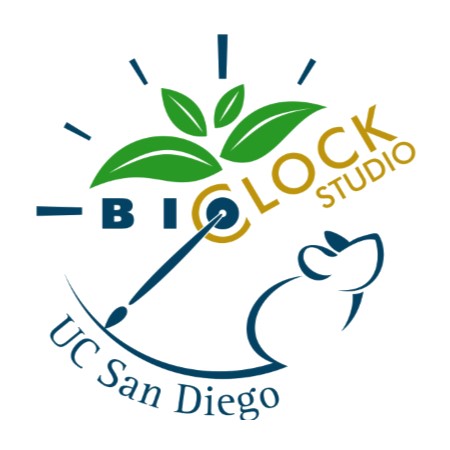Actogram: A graphical representation of an organism’s phases of activity and rest over the course of a day
Aftereffect: Ongoing characteristics of a rhythm (altered phasing, period length, or amplitude) resulting from previous stimulation. E.g.: lengthening of FRP due to prior entrainment by a zeitgeber-cycle with a period longer than that of the organism’s normal FRP.
Circadian: Meaning “about a day;” any rhythm can be described as circadian if its period is approximately 24h.
Circadian Clock: The endogenous, molecular mechanism which accounts for observable circadian rhythms in an organism’s activities (including locomotion, sleep-wake cycles, metabolism and more).
Circadian Time (CT): A quantification of time as defined by an organism’s endogenous circadian clock, without reference to any environmental regularities or zeitgebers.
Clock: A timekeeping device; sometimes more narrowly understood as an oscillating time-keeping device (such as an analog clock, rather than an hourglass)
Diurnal: An organism that displays activity during the day (in light conditions) and during subjective day (in constant conditions)
Double-Plotted (Actogram): An actogram in which the values on the x-axis range over two Zeitgeber-cycles (usually, 24h+24h=48h), resulting in a duplication of displayed data.
Empirical: Having to do with observable results; grounded in experience.
Endogenous: Growing or working from within an organism; intrinsic.
Endogenous, Self-Sustained Oscillator (ESSO): A mechanism that produces rhythmic (repetitive) variations, and can continue to do so for numerous repetitions without external influences.
Entrainment: The coupling of an observable rhythm in an organism to a zeitgeber resulting in shared period, where (in contrast to masking) this change is caused by an alteration of the endogenous clock that schedules the observable rhythm.
Freerunning: An organism that is in constant conditions (LL or DD) and not exposed to any exogenous time cues
Free-Running Period (FRP): The length of time it takes for an organism’s endogenous rhythm to repeat (return to the same phase) in the absence of environmental time cues.
Long Period (Long FRP): A free-running period (FRP) that is longer than 24 solar hours.
Masking: The apparent coupling of an observable rhythm in an organism to a zeitgeber resulting in shared period, where (in contrast to entrainment) this change is not caused by an alteration of the endogenous clock that schedules the observable rhythm.
Model: A stand-in or representative system that enables inferences about some target system. Includes mathematical or formal models, as well as concrete models (e.g, model organisms).
Nocturnal: An organism that is active during the night (in light conditions) and during subjective night (in constant conditions)
Onset of Activity: The time at which an organism’s passive (e.g., sleep) phase ends, and daily activities (e.g., locomotion) begin.
Period: Period (or Greek letter tau) generally refers to the amount of time it takes a cyclical process to return to the same phase (e.g, from one sunset to the next day’s sunset, or from an organism’s waking to the next day’s waking)
Periodicity: A system or process exhibits periodicity if it has a tendency to repeat some process at a constant interval (i.e., with some well-defined period).
Persistence in Constant Conditions: The continued occurrence of circadian rhythmicity in an organism in the absence of environmental cues regarding time of day (e.g., without a light-dark cycle).
Phase-Shift: A change (either an advance or a delay) in the phasing of an organism’s free-running circadian rhythm, usually in response to an acute stimulus
Phase Response Curve (PRC): A graph representing the varying effect that an identical stimulus has on a circadian rhythms’ phase, depending on the phase of circadian time at which it is applied.
Photoperiod: (a.k.a. Day Length) The duration of light in an external light-dark cycle. E.g., LD12:12 is a longer photoperiod than LD10:14, even though both are 24h long in total.
Q10 Temperature Coefficient: A measure of how much the rate of a process changes in response to a change of 10°C in ambient temperature; biochemical processes usually increase their rate as temperature increases, and Q10>1.
Short Period (Short FRP): A free-running period (FRP) that is shorter than 24 solar hours.
Single-Plotted (Actogram): An actogram in which the values on the x-axis range over only one zeitgeber-cycle (usually, 24h)
Skeleton Photoperiod: An external light-dark cycle in which a long period of light (the day phase) is not present, and instead short periods of light mark the beginning and end of the day phase.
Subjective Day: The phase of daylight as predicted by the organism’s endogenous clock in the absence of zeitgebers; anchored to onset of activity in diurnal organisms, but not in nocturnal organisms.”
Subjective Night: The phase of night as predicted by the organism’s endogenous clock in the absence of zeitgebers; anchored to onset of activity in nocturnal organisms, but not in diurnal organisms.
Tau τ (lowercase): The length of an organism’s endogenously-produced, free-running period; usually not exactly 24h.
Tau Τ (uppercase): The total period of an exogenous rhythm that is effective in entraining an organism. In an LD12:12 cycle, Τ=24h.
Temperature Compensation: The ability of circadian clocks to maintain a relatively constant free-running period despite fluctuations in environmental temperature.
Zeitgeber: From the German “time giver” or “synchronizer”, a zeitgeber is any external time cue that is effective in entraining an organism.
Zeitgeber Time (ZT): A quantification of time, defined with reference to environmental regularities or zeitgebers.
Click to copy citation: Kao, K., Loi, J., Sanden, H., Kim, J., Lee, J., Nudell, V., Wu, L., Golden, S.S., Gorman, M., & Sheredos, B. (2016, September 22). Introduction to chronobiology. Retrieved from https://bioclock.ucsd.edu/portfolio-item/an-introduction-to-chronobiology/.
